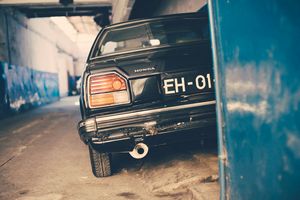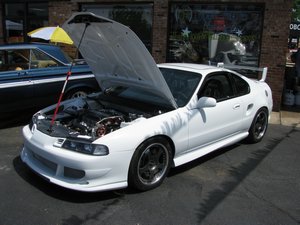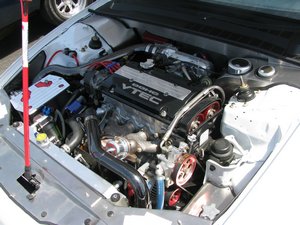















Honda Prelude |
|---|
|
| Topic Navigation |
|---|
|
Wikipedia: Honda Prelude
Page Sections History Photographs 1982 Specifications |
History
The following section is an excerpt from Wikipedia's Honda Prelude page on 31 December 2017, text available via the Creative Commons Attribution-ShareAlike 3.0 Unported License.
The Honda Prelude is a sports coupé which was produced by Japanese car manufacturer Honda from 1978 until 2001. The two-door coupé was loosely derived from the Honda Accord and spanned five generations. The Prelude was used by Honda to introduce the Japanese Honda retail sales chain called Honda Verno, with the international release of the model following shortly after.
Prelude competitors traditionally included the Toyota Celica, the Nissan Silvia and the Mitsubishi Eclipse. Production of the Prelude concluded in 2001 upon the introduction of the Honda Integra DC5.
The Prelude name was originally trademarked by Toyota, but was amicably given to Honda for use. The Prelude complied to the series of music themed vehicle names which Honda used at the time, along with the Accord, Quintet, Concerto, Jazz and Ballade.
First generation (1978–1982)
On November 24, 1978, the Prelude was launched to the Japanese market. It had its world premier at the 1979 AutoRAI in Amsterdam, two months later. In Japan it was only available at the newly established dealership sales channel Honda Verno. This dealership chain also introduced the Honda Quint, the Honda Ballade and the Accord-based Honda Vigor as its largest sedan and hatchback. The four-wheel independent struts, brakes, and engine were all borrowed from the first generation Accord, but the chassis was all new and developed by chief engineer Hiroshi Kizawa expressly for the sporting Prelude. At 4,090 mm (length) x 1,635 mm (width) x 1,290 mm (height), it had quite a low and wide profile. The wheelbase was 2,320 mm, and was 60 mm shorter than that of the original Accord. Honda appears to have followed the successful introduction of the Toyota Celica example by taking a small car, like the Accord, installing a more powerful engine, and giving the body a short trunk, and a long engine hood. The Prelude (and period Accord) were the first cars under two litres to receive standard power steering. The Prelude also benefited from Honda's experience with roadsters like the Honda S800 and Coupe 1300.
The Prelude was the first Honda model to offer a power moonroof as standard equipment, which eventually became a Prelude trademark. In Japan, the Prelude was available with a sliding metal sunroof, while US versions received a glass top which freed up more headroom. Japanese buyers were liable for slightly more annual road taxes over the smaller Civic, which also had a smaller engine. While marketed as a 2+2, the rear seat was not usable for anyone larger than a small child.
Second generation (1983–1987)
The second-generation Prelude was released in Japan on November 25, 1982 and worldwide in the spring of 1983. Riding on an all-new platform, the Prelude was initially available with an A18A or ET-2, 1.8 L 12-valve twin carburetor engine, producing 105 PS (77 kW). In Japan, Asia and Europe, it later became available with a 2-liter DOHC 16-valve PGM-FI engine (JDM = BA1, EU = BA2) although this engine was not released in Europe until 1986. The JDM B20A produced 160 PS (118 kW) at 6300 rpm, while the European B20A1 produced only 137 hp (102 kW). This was the first generation of Prelude to have pop-up headlights, which allowed for a more aerodynamic front clip, reducing drag. Opening the headlights, however, especially at higher speeds, produced significantly more drag. The design retained nothing of the first generation, being considerably more aerodynamic and with large glass surfaces. As with the predecessor, it was amply equipped, with an air of "mini-gran turismo" rather than that of a sports car. It also offered, as an option, Honda's new "A.L.B." anti-lock brakes.
In Japan, the Prelude was one of the key models sold at Japanese Honda dealership sales channels, called Honda Verno, which offered performance-oriented products. All Honda Verno products, like the Vigor, initially shared the concealed headlights introduced with this generation Prelude that would help identify "sports" products from Honda in Japan however, the approach was short-lived. The model with the 2.0 litre engine was regarded as the top level car in Japan because Japanese buyers were liable for a higher annual road tax over the car with the 1.8 litre engine. The Japanese 1.8 had CVCC and claimed 125 PS (92 kW), considerably more than export models.
Third generation (1987-1991)
On April 9, 1987, the third-generation Prelude was released in the Japanese domestic market and released later that year worldwide, being an 1988 model in North America. Featuring evolutionary styling from its predecessor, it shared design cues from the Honda NSX that would be introduced later in 1989. The Prelude featured innovative features for its time such as a 0.34 drag coefficient, roof pillars made of high-strength metal and its signature feature, the available option of the world's first mechanical four wheel steering system available in a mass-production passenger car. Honda had expected 30% of buyers to plump for four-wheel-steering, but the car was a runaway success in the home market and 80% of buyers did in the first year.
The third-generation Prelude was exclusively powered by variants of the Honda B20A engine, a base carbureted version with a SOHC 12-valve valvetrain, or a DOHC variant with Honda's PGM-FI fuel injection and 16 valves. The engine was tilted backwards by 18 degrees, which made it possible to make the hood 30 mm (1.2 in) lower than on the previous generation.
It was well received by judges of the European Car of the Year accolade for 1988, finished third in a contest where the Peugeot 405 was the runaway winner and the Citroen AX came second. This was one of the best performances by a Japanese built or branded car until the Nissan Micra won the award five years later.
Fourth generation (1991–1996)
On September 19, 1991, the fourth-generation Prelude was introduced in Japan, and in Europe from early 1992. The car had a 58% front and 42% rear weight distribution. The four wheel steering system was changed to an electronic version and the engine was increased in capacity from 2.1 litres to 2.2 litres for the base model "S" (SOHC F22A1 engine, 135 PS (99 kW; 133 hp) at 5200 rpm, 203 N⋅m (150 ft⋅lbf) at 4000 rpm) and "VTEC" model (DOHC VTEC H22A1, 190 PS (140 kW; 187 hp) at 6800 rpm, 207 N⋅m (153 ft⋅lbf) at 5500 rpm), with a 2.3-litre for the "Si" (DOHC H23A1, 160 PS (118 kW; 158 hp) at 5800 rpm, 212 N⋅m (156 ft⋅lbf) at 5300 rpm). The Japanese Si came with the F22B (2.2 L DOHC non-VTEC, 160 PS (118 kW; 158 hp)). The VTEC model had an upgraded brake system, going from a 10.3" (262 mm) front rotor to an 11.1" (282 mm) front rotor and utilizing larger brake caliper and pads, similar to those found in the Honda Vigor. Its styling approach is similar to the Honda Ascot Innova during the same time period.
Fifth generation (1997-2001)
Introduced on November 7, 1996, the fifth generation retained an FF layout with an independent front suspension and 63/37 weight distribution. Most fifth-generation Honda Preludes came with 16-inch (410 mm) aluminium alloy wheels with all-season 205/50 R16 87V tires. Most fifth-generation models featured the 11.1" front brakes like the '96 VTEC model, and most Preludes also received a five-lug hub (not the four-lug wheel hub of older models). The Prelude was only available in three models for Canada and two models for the US (the Base and Type SH); Canada's market included the SE as well. All models came with 16-inch alloy wheels and 200 PS (200 hp). The 2.0i and JDM Si trims came with 195/60 R15 steel wheel, and the JDM Xi came with 14" steel wheels. Unlike the US market Preludes, JDM Preludes came with rear wind screen wipers, except for the Xi.
The fifth-generation Prelude marked a return to the more square body style of the third generation (1988–1991), in an attempt to curb slumping sales of the fourth-generation body style. All models and trim packages stayed within the BB-chassis code (BB5-BB9) and housed either an H-series or F-Series engine.
 |
Porto, Portugal Photo by Max Kaharlytskyi on Unsplash View photo of Modified Honda Prelude - 1.7MB |
 |
Modified Photo ©2009 Bill Crittenden 2009 Nostalgia Auto Show View photo of Modified Honda Prelude - 3,208KB |
 |
Modified Photo ©2009 Bill Crittenden 2009 Nostalgia Auto Show View photo of Modified Honda Prelude - 3,169KB |
 |
Modified Photo ©2009 Bill Crittenden 2009 Nostalgia Auto Show View photo of Modified Honda Prelude - 3,995KB |
| 0-60 mph* | 11.5 seconds |
| 80-0 mph* | 256 feet |
| Cornering Capability* | 0.743g |
| Interior Noise @ 70mph* | 74 dBA |
| Fuel Economy* | 29.0 mpg |
